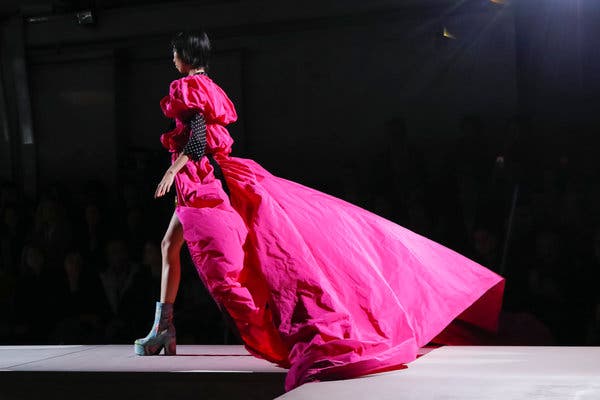PARIS — If only Blaine Trump had been here to see it. The pouf skirt, relic of the go-go 1980s, favorite party dress of the Wives of Wall Street, is back. Only, now it is in the shape of a sleeve (singular). Also a waistband. That’s a tell.
It made its return Wednesday afternoon in the raw concrete innards behind the stage of the Opéra Bastille. And it made its return because Dries Van Noten, a designer whose arrival on the Paris fashion scene back in the ’80s as part of the Antwerp Six effectively provided an antidote to everything pouf-like, made a call to a man who was then king of exactly that kind of fantastical aspirational dressing: Christian Lacroix.
A man who scaled the heights of luxury only to later become its cautionary tale: the first brand that LVMH Moët Hennessy Louis Vuitton started from scratch, and the first it sold, starting a downward trend that ultimately resulted in Mr. Lacroix losing the rights to his name, saying goodbye to the runway in 2009, and starting a new career as a theatrical designer.
Until Mr. Van Noten asked him to come back, for one time only. Because sometimes, seeing the familiar from someone else’s perspective makes all the difference. Sometimes, engaging in negotiation with a different point of view gives you the best possible result.
It’s a truism that applies to a lot more than fashion.
But for now, Mr. Lacroix’s excess, his adoration of the baroque and rococo, his ability to say “pourquoi pas?” (“why not?”), and Mr. Van Noten’s love of the ever-so-elevated-everyday (the painter’s pants with an embroidered flower; the jacket with a sparkling appliqué) met in a 68-look give-and-take of priorities — casual versus decorative, elaborate versus easy — that was in all ways more than the sum of its parts.
Over the base of simple white jeans or shorts and a white singlet were layered ruched and ruffled taffeta tops (only they weren’t taffeta, they were polyester made from recycled plastic that looked like taffeta); big, explosive skirts, in Old Dutch florals or graphic swirls, tiered and frilled and hiked up on the side to show the cool beneath or left to billow grandly behind (all 130 feet or so of fuchsia).

Often there was a sweatshirt slouched on top. A single black bejeweled feather was worn like a cross-body sword across a ribbed cotton tank top. Jackets were brocade and long or matador-short and encrusted with gold bullion. Coats were shrugged off shoulders and worn like wraps, trailing like royal robes. Leopard played a role; so did zebra, So did neon. Giant polka dots. Opera gloves. Ribbons. Small, squishy brocade bags. Color was everywhere, and then there would be a cleansing breath of black.
The ’80s references were muted; a benediction on a moment that had become less “look at me” and more “once upon a time.” At the end, Mr. Van Noten and Mr. Lacroix appeared in matching black crew necks and dark pants, their bride — her white denim and white tank covered in a cascade of sheer tulle ruffles — between them. As if any more proof were needed that this had been a happy marriage.
It is rare in fashion to be given a glimpse into a designer’s mind, but Mr. Van Noten has always been generous that way (he had a retrospective that involved giving credit to all the other work that inspired him). This was like being allowed to listen in on a fascinating conversation between equals, and watching the ideas at play.
Collaborations can seem like a hackneyed exercise by now, there are so many: high fashion designers working with mass market brands, musical artists signing on to do sneakers, celeb faces working with designers and demanding their own capsule line; all of it seeming, increasingly, like the most naked form of mutual back scratching, based on little more than money and marketing.
But this was something else: a reminder that at its purest, creative collaboration is a meeting of the eyes and the minds. Not to mention a solution to the modern ill of appropriation, be it styles or culture. Mr. Van Noten said, in an interview the morning after the show, that when he realized he had tacked up numerous photos of Mr. Lacroix’s work on his mood board, he thought that instead of creating an homage, he would go straight to the source.
“Homage is often just another word for ripping off other people’s ideas,” he said. It’s also classic fashion sleight of hand.
The fact that Mr. Van Noten tried a different approach, and the creative flowering engendered by recognizing a peer’s work and giving it the credit it deserves, is a lesson as elegant as any silhouette.







